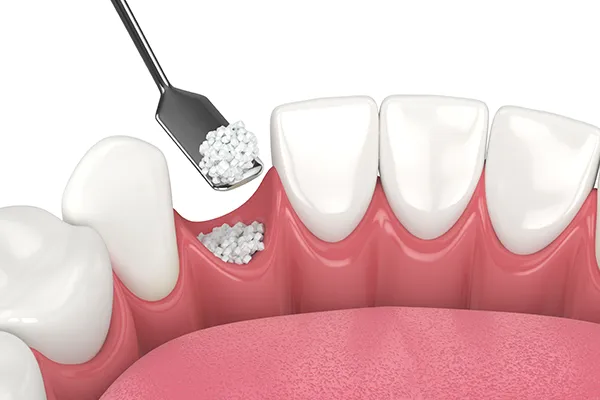Home
› Our Comprehensive Treatment Solutions
› Bone Grafting
Bone Grafting
Annapolis, MD
Bone Grafting provided by Dr. Djawdan
in Annapolis, MD at Djawdan Center for Implant and Restorative Dentistry
 Enhancing Dental Implant Success with Precision and Care
At the Djawdan Center for Implant and Restorative Dentistry, bone grafting is performed with meticulous attention to detail to ensure the successful placement of dental implants. This procedure is crucial for patients lacking sufficient bone structure due to resorption or other factors, enabling proper implant alignment and integration.
What is Bone Grafting?
Bone grafting is a specialized procedure used to rebuild or enhance bone density in the jaw where bone loss has occurred. This is often necessary for patients with significant bone loss from periodontal disease, tooth loss, or injury. By augmenting the jawbone, bone grafting allows for the proper placement and long-term success of dental implants.
Why Is Bone Grafting Needed?
| • |
Implant Placement: Bone grafting may be necessary to provide adequate bone volume and density for implant placement, ensuring that implants are correctly aligned with other teeth.
|
| • |
Socket Preservation: Following tooth extraction, bone grafting is often performed to preserve the socket. This process helps maintain the alveolar ridge structure, preventing the bone from collapsing and providing a solid foundation for future implants.
|
| • |
Long-term Stability: Bone grafting stabilizes the dental implant, providing a secure base that is essential for the functionality and longevity of the implant. |
Our Bone Grafting Process:
| 1. |
Advanced Diagnostic Imaging: Utilizing state-of-the-art 3D imaging technology, we evaluate the jawbone's condition to simulate the placement of the dental implant. This helps us determine whether bone grafting is required and the precise volume of bone needed.
|
| 2. |
Graft Material Selection: We exclusively use human donor bone sourced from reputable tissue banks, ensuring the highest quality and compatibility for bone grafting procedures.
|
| 3. |
Surgical Procedure: Performed under local anesthesia with sedation options for maximum comfort, the graft material is meticulously placed in areas of deficiency.
|
| 4. |
Healing and Integration: Post-surgery, the natural bone integrates with the graft material over several months, forming a strong, stable foundation for future implants. |
Why Choose the Djawdan Center for Bone Grafting?
| • |
Cutting-Edge Technology: Our commitment to using advanced 3D imaging and planning techniques ensures precise assessments and outcomes in bone grafting.
|
| • |
Expertise in Regenerative Procedures: Our team's proficiency in regenerative techniques maximizes the success rate of bone grafts and subsequent implant procedures.
|
| • |
Tailored Patient Care: We understand that each patient's needs are unique, thus, we customize our procedures to align perfectly with your dental restoration goals. |
Start Your Journey Towards a Stronger Smile
If you are considering dental implants and may require bone grafting, the Djawdan Center is equipped to guide you through this advanced treatment process. Contact us today to schedule a consultation and discover how bone grafting can be a critical step in achieving a durable, aesthetically pleasing dental implant solution.
Request an Appointment
FAQs
What is bone grafting in dentistry?
Bone grafting in dentistry is a procedure that involves adding bone or bone-like materials to the jaw to create a solid foundation for dental implants. This process helps regenerate bone in areas where it has been lost due to tooth extraction, periodontal disease, or other factors.
Why is bone grafting necessary for dental implants?
Bone grafting is necessary for dental implants when there isn't enough natural bone to support the implant. Insufficient bone can result from tooth loss, gum disease, or trauma. Grafting provides the needed bone volume and density for stable and successful implant placement.
What types of bone grafting procedures are available?
Types of bone grafting procedures include site preservation, bone grafting at the time of implant placement, sinus augmentation, ridge augmentation, and ridge expansion. Each method addresses specific bone deficiencies to ensure successful implant placement and long-term dental health.
What is sinus augmentation?
Sinus augmentation, or sinus lift, is a procedure that increases bone height in the upper jaw by lifting the sinus membrane and adding bone graft material. This is often necessary when there is insufficient bone height for implant placement in the posterior maxilla.
How long does bone grafting take to heal?
Healing time for bone grafting varies depending on the procedure and the individual's health. Generally, it takes several months for the new bone to integrate and become strong enough to support a dental implant. Your dentist will monitor the healing process and determine the appropriate time for implant placement.
What are the risks associated with bone grafting?
Risks associated with bone grafting include infection, graft rejection, and complications from surgery such as swelling or bleeding. However, these risks are relatively low, and most patients recover without any issues. Your dentist will discuss potential risks and how to minimize them during your consultation.
Is bone grafting painful?
Bone grafting is performed under local anesthesia, so you should not feel pain during the procedure. Some discomfort and swelling may occur after the surgery, but this can usually be managed with over-the-counter pain medication and ice packs.
What materials are used in bone grafting?
Materials used in bone grafting can include autografts (bone taken from another part of your body), allografts (donor bone), xenografts (bone from animal sources), and synthetic materials. Your dentist will choose the best option based on your specific needs and health condition.
Can anyone undergo bone grafting?
Most people can undergo bone grafting, but it depends on individual health factors. Your dentist will evaluate your overall health, medical history, and specific dental needs to determine if you are a suitable candidate for the procedure. |


